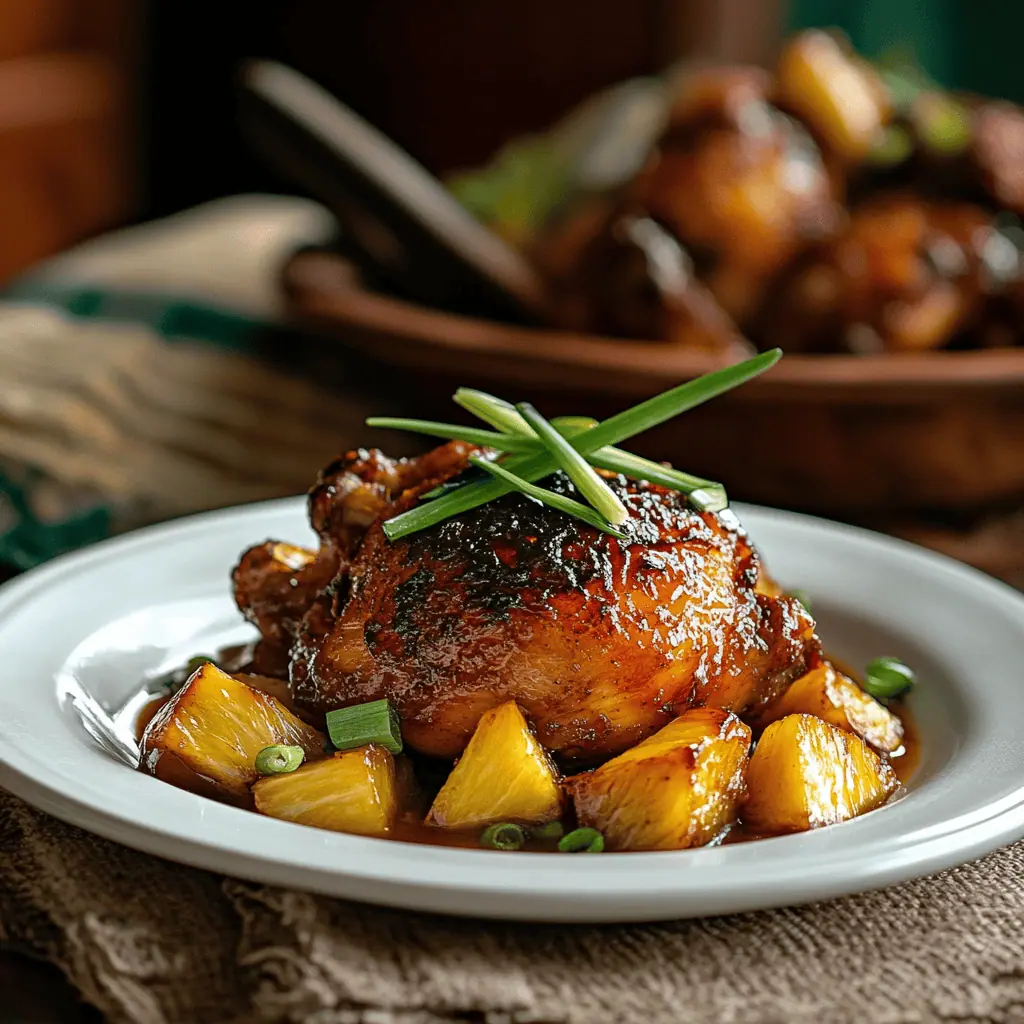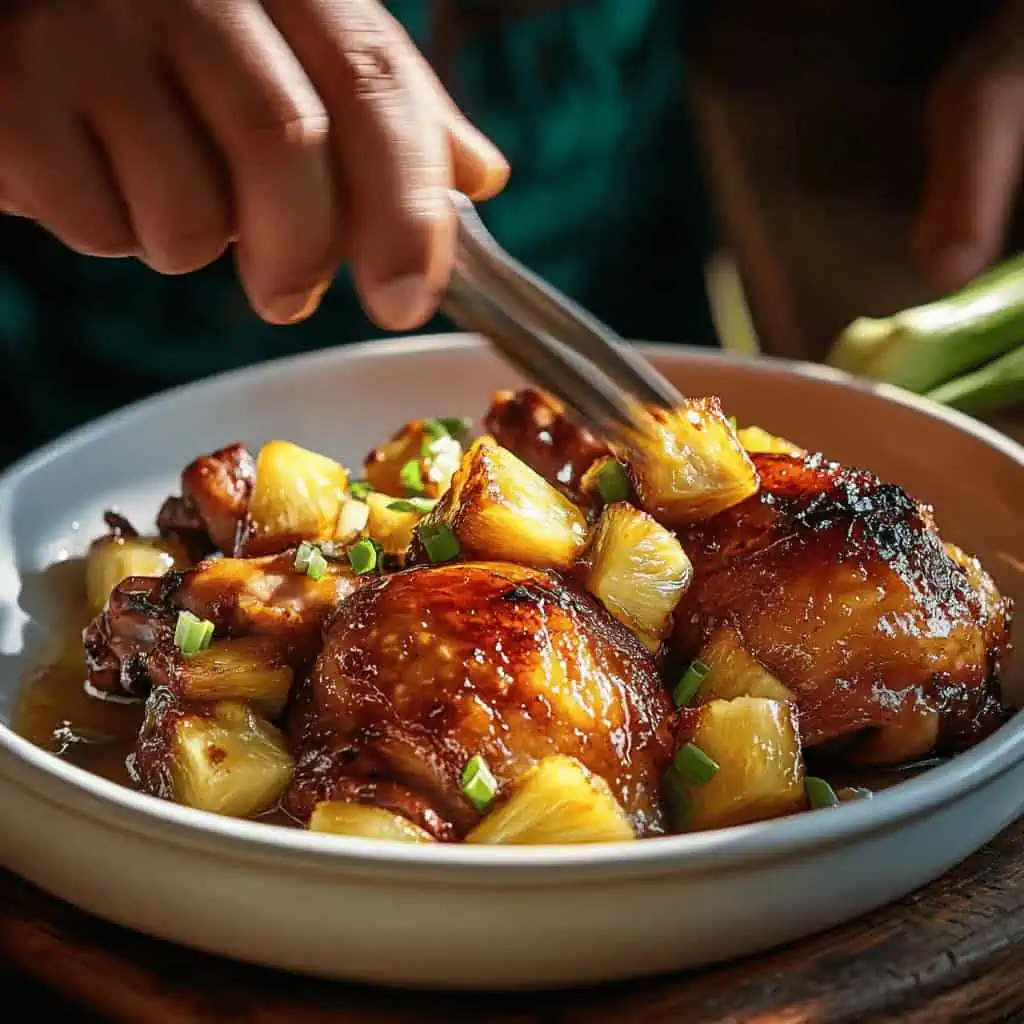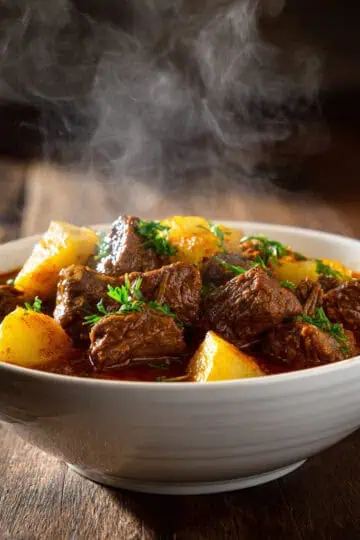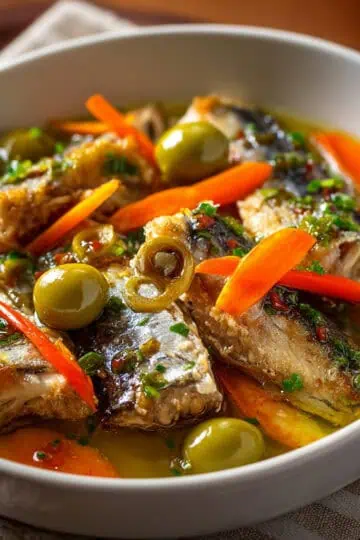My Lola's Tiniim na Manok truly brought magic to our table. This melt-in-your-mouth braised chicken, slowly cooked in pineapple juice until it absorbs every drop of flavor, always takes me back to those precious family gatherings. While adobo might be more famous, this sweet-savory chicken dish holds a special place in Filipino home cooking. It's less common, but absolutely unforgettable.
After years of watching my grandmother make this dish, I've perfected her recipe, and now my own kids' eyes light up when they smell that familiar aroma of pineapple, soy sauce and ginger through our kitchen.
This easy, one-pot wonder will become your new family favorite. It's practically impossible to mess up. And the sauce? Let's just say you'll want to drizzle it over everything!
What is Tiniim?
"Tiniim" comes from the Tagalog root word "tiim," which means to absorb or soak up. In Filipino cooking, it refers to a traditional cooking method where meat (typically chicken or pork) is slowly simmered in a flavorful liquid until it fully absorbs the seasonings, making the meat incredibly tender and infused with flavor from the inside out.
When used in Tiniim na Manok, this technique allows the chicken to slowly take in the sweet-savory combination of pineapple juice and soy sauce, while the low, slow cooking process breaks down the meat's fibers for maximum tenderness.
Unlike quick-cooking methods, tiniim requires patience - it's this unhurried absorption that gives the dish its distinctive depth of flavor and melt-in-your-mouth texture.
Jump to:

Why You'll Love This Recipe
- One-pot wonder: Minimal cleanup required
- Budget-friendly family meal
- Perfect balance of sweet and savory flavors
- Fork-tender, juicy chicken every time
- Make-ahead friendly for busy weeknights
- Restaurant-quality dish at home
- Versatile leftovers
Ingredients

For the Chicken:
- 1 whole chicken (4-5 lbs / 2-2.5 kg)
- 3 cups unsweetened pineapple juice
- ½ cup soy sauce
- ¼ cup brown sugar
- ½ cup pineapple tidbits
- 2 shallots, minced
- 4 cloves garlic, minced
- 1 thumb-sized ginger, sliced
- 1 tablespoon salt
- 1 teaspoon whole peppercorns
For the Sauce:
- ¼ cup cornstarch
- ¼ cup water
Equipment
- Large Dutch oven or heavy-bottomed pot: For even heat distribution and proper braising
- Kitchen twine: For trussing the chicken to ensure even cooking
- Meat thermometer: For ensuring the chicken reaches a safe internal temperature
- Colander: For straining the sauce
- Wooden spoon: For gentle stirring without scratching your pot
- Sharp knife: For butchering or carving the chicken
- Measuring cups and spoons: For precise ingredient measurements
- Whisk: For creating a smooth, lump-free sauce

How To Make
- Prepare the chicken: Rinse thoroughly and pat completely dry. Truss the chicken using kitchen twine to ensure even cooking. Let it come to room temperature.
- Create the braising liquid: In a Dutch oven or heavy-bottomed pot, combine pineapple juice, soy sauce, and brown sugar. Bring to a boil, stirring until sugar dissolves completely. Add pineapple tidbits, minced shallots, minced garlic, sliced ginger, salt, and whole peppercorns.
- Braise the chicken: Lower heat to medium-low. Add the chicken, cover, and simmer for 20-30 minutes. If the chicken isn't fully submerged, turn it occasionally. Cook for an additional 10 minutes or until internal temperature reaches 165°F (74°C).
- Prepare the sauce: Remove chicken and keep warm. Strain the cooking liquid and discard solids. Bring sauce to a boil. Make a slurry by combining cornstarch and water, then whisk into the boiling sauce. Simmer until thickened, about 2-3 minutes.
- Serve: Let chicken rest for 10 minutes before cutting. Serve with the thickened sauce, steaming white rice, and traditional accompaniments like pickled papaya (atchara) or cucumber salad.

Tips from Lola's Kitchen
- Choose a native chicken for more authentic flavor and better texture
- Add banana blossoms to the braising liquid for extra authenticity and depth of flavor
- Always let the chicken rest for at least 10 minutes before cutting to keep juices inside
- Reserve the chicken drippings to mix with your rice for an extra flavorful side dish
- Use pineapple juice from fresh fruit when available for a brighter, more complex flavor
- Don't rush the braising process – the magic happens with time and patience
- Taste the sauce before thickening and adjust seasonings if needed
- For extra flavor depth, sear the chicken in a little oil before braising
Substitutions
- Pineapple juice: Calamansi juice mixed with water and a touch of honey
- Brown sugar: Muscovado sugar, coconut sugar, or honey (adjust quantities to taste)
- Whole chicken: Chicken parts (thighs and drumsticks work best; adjust cooking time to about 20-25 minutes)
- Cornstarch: All-purpose flour (use 2 tablespoons flour per ¼ cup cornstarch)
- Shallots: Red onions or yellow onions (about ¼ cup minced)
- Fresh ginger: 1 teaspoon ground ginger (though fresh is strongly preferred)
- Soy sauce: Coconut aminos for a gluten-free option (may need extra salt)
- Pineapple tidbits: Fresh pineapple chunks or omit if unavailable
Troubleshooting
Tough Chicken:
- Issue: Chicken isn't tender enough after the recommended cooking time
- Solution: Lower the heat further and extend cooking time by 15-20 minutes
- Prevention: Ensure you're using medium-low heat and keep the pot covered
Watery Sauce:
- Issue: Sauce isn't thick enough after adding cornstarch
- Solution: Make another small batch of cornstarch slurry and gradually add while whisking
- Prevention: Ensure your sauce is boiling when you add the slurry, and simmer uncovered to reduce
Too Sweet:
- Issue: The final dish tastes overly sweet
- Solution: Add 1-2 tablespoons of calamansi juice, lime juice, or a splash of vinegar
- Prevention: Use unsweetened pineapple juice and reduce sugar to 2 tablespoons
Burnt Bottom:
- Issue: Sauce is sticking and burning on the bottom of the pot
- Solution: Transfer to a new pot without scraping the burnt bits, add a little water
- Prevention: Use a heavy-bottomed pot and maintain low, gentle heat
Bland Flavor:
- Issue: The dish lacks depth of flavor
- Solution: Add 1 tablespoon of fish sauce and a bay leaf, simmer for 10 more minutes
- Prevention: Use good quality soy sauce and ensure proper salt level
Storage & Reheating
Refrigerator Storage:
- Store in an airtight container for 3-4 days
- Keep the sauce separate for best results
- Cool completely before refrigerating
Freezer Storage:
- Freeze for up to 3 months in freezer-safe containers
- Portion into meal-sized amounts for easier reheating
- Thaw overnight in the refrigerator before reheating
Reheating Methods:
- Stovetop: Place chicken and sauce in a covered pan on low heat for 10-15 minutes, adding a splash of water if needed
- Oven: Place in an oven-safe dish, cover with foil, and heat at 300°F (150°C) for 20 minutes
- Microwave: Place in a microwave-safe dish with sauce, cover, and heat for 2-3 minutes, turning halfway through

FAQ
Can I make this ahead of time?
Yes! The flavors actually improve overnight as the chicken continues to absorb the sauce. Make it a day ahead and gently reheat before serving.
Can I use chicken parts instead of a whole chicken?
Absolutely! Bone-in, skin-on thighs and drumsticks work best. Adjust cooking time to about 20-25 minutes or until internal temperature reaches 165°F (74°C).
Is this dish freezer-friendly?
Yes, it freezes well for up to 3 months. Thaw overnight in the refrigerator before reheating.
Can I cook this in a slow cooker?
Yes! Add all ingredients to your slow cooker and cook on high for 4 hours or low for 8 hours. Thicken the sauce on the stovetop afterwards.
What makes Tiniim different from Adobo?
While both are braised Filipino chicken dishes, Tiniim uses pineapple juice for sweetness and tenderizing, whereas Adobo relies on vinegar for its signature tangy flavor.
How do I know when the chicken is done?
The safest method is using a meat thermometer - the internal temperature should reach 165°F (74°C). The meat should also easily pull away from the bone.
Can I make this dish less sweet?
Yes, reduce the brown sugar or omit it entirely, relying on the natural sweetness of the pineapple juice.
What can I serve with Tiniim na Manok?
Traditional accompaniments include steamed white rice, pickled papaya (atchara), cucumber salad, or a simple green salad.
Related
Looking for other recipes like this? Try these:

Tiniim na Manok (Filipino Pineapple-Braised Chicken)
Equipment
- Large Dutch oven or heavy-bottomed pot (Kaldero) For even heat distribution
- Kitchen twine (Pisi) For trussing the chicken
- Meat thermometer For ensuring proper doneness
- Colander (salaan) For straining the sauce
- Wooden spoon (sandok na kahoy) For gentle stirring
- Sharp knife (Matador na kutsilyo) For butchering
- Measuring cups and spoons (mga panukat)
- Whisk (Panghalo) For smooth sauce preparation
Ingredients
For the Chicken:
- 1 whole chicken 4-5 lbs / 2-2.5 kg
- 3 cups unsweetened pineapple juice Katas ng pinya
- ½ cup soy sauce Toyo
- ¼ cup brown sugar Asukal na pula
- ½ cup pineapple tidbits
- 2 shallots minced (Sibuyas tagalog)
- 4 cloves garlic minced (Bawang)
- 1 thumb-sized ginger sliced (Luya)
- 1 tablespoon salt Asin
- 1 teaspoon whole peppercorns Paminta
For the Sauce:
- ¼ cup cornstarch Gawgaw
- ¼ cup water Tubig
Instructions
- Begin by preparing the chicken (ihanda ang manok). Rinse thoroughly and pat completely dry. Truss the chicken using kitchen twine (talian ang manok) to ensure even cooking. Let it come to room temperature.
- In a Dutch oven or heavy-bottomed pot (kaldero), combine pineapple juice (katas ng pinya), soy sauce (toyo), and brown sugar (asukal na pula). Bring to a boil (100°C/212°F), stirring until sugar dissolves completely. Add pineapple tidbits, minced shallots (sibuyas tagalog), minced garlic (bawang), sliced ginger (luya), salt (asin), and whole peppercorns (paminta).
- Lower heat to medium-low (82-88°C/180-190°F). Add the chicken, cover, and simmer for 20-30 minutes. If the chicken isn't fully submerged, turn it occasionally. Cook for an additional 10 minutes or until internal temperature reaches 74°C/165°F.
- Remove chicken and keep warm. Strain the cooking liquid (salain ang sabaw) and discard solids. Bring sauce to a boil. Make a slurry by combining cornstarch (gawgaw) and water (tubig), then whisk into the boiling sauce. Simmer until thickened, about 2-3 minutes.
- Let chicken rest for 10 minutes before cutting. Serve with the thickened sauce, steaming white rice (kanin), and traditional accompaniments like pickled papaya (atchara) or cucumber salad (ensaladang pipino).
Tips from Lola's Kitchen
- Choose a native chicken (Manok na native) for more authentic flavor
- Add banana blossoms (Puso ng saging) for extra authenticity
- Let chicken rest 10 minutes before cutting
- Reserve chicken drippings for extra flavorful rice
- Use pineapple juice from fresh fruit when available
Nutrition
The Story Behind Tiniim na Manok (Filipino Pineapple-Braised Chicken)
In the heart of Filipino home cooking lies Tiniim na Manok, a dish that beautifully represents our culture's genius for transforming simple ingredients into something extraordinary. While not as internationally famous as adobo or as elaborate as lechon, this pineapple-braised chicken has been quietly gracing Filipino family tables for generations, particularly in regions where pineapples grow abundantly.
The technique of "tiniim" - which means "to absorb" in Tagalog - dates back to our ancestors' practical need to preserve meat while maximizing flavor. They discovered that slowly simmering chicken in pineapple juice not only helped tenderize the meat but also created a natural preservation method, as pineapple's acidity helps extend the dish's shelf life. This same acidity, combined with the fruit's natural enzymes (particularly bromelain), breaks down the protein fibers in the chicken, resulting in incredibly tender meat.
What makes this dish particularly special in Filipino cuisine is its clever use of pineapple - a fruit that arrived in our islands through the Manila-Acapulco Galleon Trade in the 16th century. Over time, local cooks adapted this tropical fruit into our cuisine, creating dishes like Tiniim na Manok that perfectly balance sweet, savory, and umami flavors. Unlike the vinegar-based adobo or the citrus-forward sinampalukang manok, Tiniim na Manok stands out for its subtle sweetness and rich, caramelized notes.
Today, this dish remains a testament to Filipino ingenuity in the kitchen - how a simple combination of chicken, pineapple juice, and aromatics can create something so comforting yet sophisticated. While every family has their own version, the core technique of allowing the meat to slowly absorb the flavors remains the same, making Tiniim na Manok a beloved part of our culinary heritage that continues to bring families together around the dinner table.










Comments
No Comments